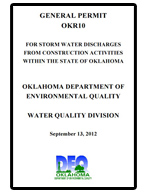
| Resources for the Construction Industry |
WHAT YOU NEED TO KNOW:
The Oklahoma Department of Environmental Quality (DEQ) has jurisdiction over the stormwater permit program. Qualifying projects must develop a Stormwater Pollution Prevention Plan (SWP3) and apply for coverage under the State’s OKR10 General Permit for Construction Activities. The general permit specifies all requirements that each project must meet.
DEQ Stormwater Permits for Construction Sites – this website has links to the State’s OKR10 General Permit for Construction Activities as well as additional information on the State level. OKR10 has many requirements, including performing dry and wet weather inspections of the project site. The SWP3 must clearly describe and show on a map all stormwater Best Management Practices (BMPs) that will be deployed. The best resources about the types and adequacy of BMPs and their proper installation will be the consulting engineering services that help design the project. |
 |
Every Phase I and Phase II permitted city and county must use inspection and enforcement under their own stormwater permit to ensure that there are no pollutants coming from the project site. The construction site owner or operator must decide upon the best suite of BMPs to be utilized.
IMPORTANT NOTICE: Each 5-year renewal of OKR10 brings many changes to what construction site operators must do to comply. For this round, there are new requirements to address Total Maximum Daily Loads (TMDLs), Aquatic Resources of Concern (ARC), Outstanding Resource Waters (ORWs), and 303(d) listed impaired waterbodies. If a construction site has the potential to impact any of these areas, OKR10 has specific requirements, including use of vegetated buffers. Consult the DEQ OKR10 permit or contact DEQ stormwater staff for specific information about these special requirements.
| WHY ARE CONSTRUCTION ACTIVITIES CONSIDERED POLLUTION SOURCES? Why is dirt in a stream considered a pollutant? Isn’t dirt (“sediment”) a natural part of the stream? The answer lies in the quantity of sediment. Too many sediment deposits cover habitat used by stream organisms such as fish and aquatic insects. When their “homes” get filled in, they cannot forage for food or seek shelter from predators. Sediment runoff to streams also clogs fish gills. Fish can essentially choke on these tiny particles, so they avoid areas having high suspended solids. Toxic substances also attach to fine sediment particles. As the particles are carried downstream, the toxic substances are transported along with them. Excess sediments can also build up in the storm drainage systems causing blockages. Flood damage to property can result. Sediment in streets and streams is an unsightly nuisance, and it is not appreciated by owners trying to sell nice lots in attractive developments. Chemical pollutants from construction activities include fertilizers, paints, solvents, gasoline, diesel fuels, oils, antifreeze, pesticides, degreasers, transmission and hydraulic fluids, and cleaning chemicals. Even paper, cardboard and plastic trash discarded on-site are considered to be pollutants. OKR10 requires all of these pollutants to be controlled to protect local water quality. |
CONSTRUCTION STORMWATER LINKS:
EPA Stormwater Discharges from Construction Activities – this website provides an EPA overview of impacts of stormwater runoff from construction activities on water quality, including numerous links to guidance and stormwater permit resources.
DEQ Stormwater Permits for Construction Sites – this website has links to the State’s OKR10 General Permit for Construction Activities as well as additional information on the State level.
Construction Industry Compliance Assistance Center - this is a highly recommended website for the construction industry. It has numerous resources and answers many questions about stormwater and other pollutant controls at construction sites and the permit process.
OKR10 General Permit for Construction Activities – with this link, the general permit and application forms can be downloaded. OKR10 also specifies what must be included in each project’s SWP3.
Home Builders Association of Greater Tulsa – this website has much information about construction projects in the Tulsa area, including resources and contacts for further information.
Oklahoma State Home Builders Association – this website provides professional information pertaining to construction in the State, including information about certifications and latest trends and important programs.
Helpful Information:
• Construction Site Best Management Practices
• Post-Construction Stormwater Guide and Check List for Stormwater Compliance
